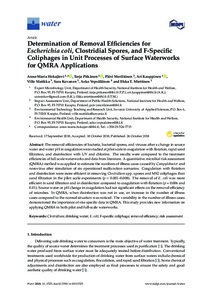Determination of Removal Efficiencies for Escherichia coli, Clostridial Spores, and F-Specific Coliphages in Unit Processes of Surface Waterworks for QMRA Applications
Hokajärvi, Anna-Maria; Pitkänen, Tarja; Meriläinen, Päivi; Kauppinen, Ari; Matikka, Ville; Kovanen, Sara; Vepsäläinen, Asko; Miettinen, Ilkka T. (2018)
Hokajärvi, Anna-Maria
Pitkänen, Tarja
Meriläinen, Päivi
Kauppinen, Ari
Matikka, Ville
Kovanen, Sara
Vepsäläinen, Asko
Miettinen, Ilkka T.
2018
Julkaisun pysyvä osoite on
https://urn.fi/URN:NBN:fi-fe201902114477
WATER
https://urn.fi/URN:NBN:fi-fe201902114477
WATER
Tiivistelmä
The removal efficiencies of bacteria, bacterial spores, and viruses after a change in source water and water pH in coagulation were studied at pilot scale in coagulation with flotation, rapid sand filtration, and disinfection with UV and chlorine. The results were compared to the treatment efficiencies of full-scale waterworks and data from literature. A quantitative microbial risk assessment (QMRA)-method was applied to estimate the numbers of illness cases caused by Campylobacter and norovirus after simulation of six operational malfunction scenarios. Coagulation with flotation and disinfection were more efficient in removing Clostridium spp. spores and MS2 coliphages than sand filtration in the pilot scale experiments (p < 0.001–0.008). The removal of E. coli was more efficient in sand filtration and in disinfection compared to coagulation with flotation (p = 0.006 and 0.01). Source water or pH change in coagulation had not significant effects on the removal efficiency of microbes. In QMRA, when disinfection was not in use, an increase in the number of illness cases compared to the normal situation was noticed. The variability in the number of illness cases demonstrated the importance of site-specific data in QMRA. This study provides new information on applying QMRA in both pilot and full-scale waterworks. View Full-Text
Kokoelmat
- Artikkelit [16242]
